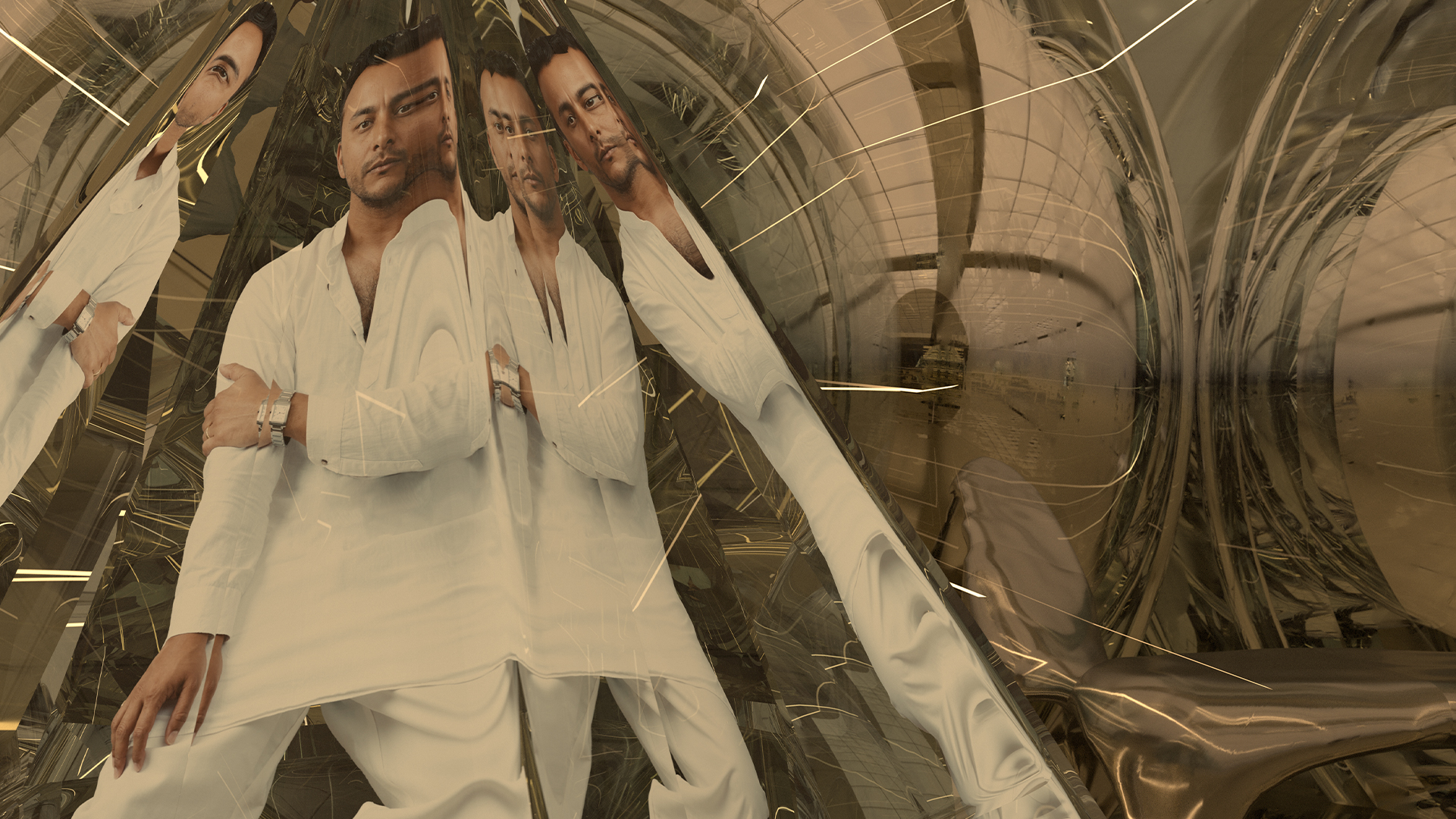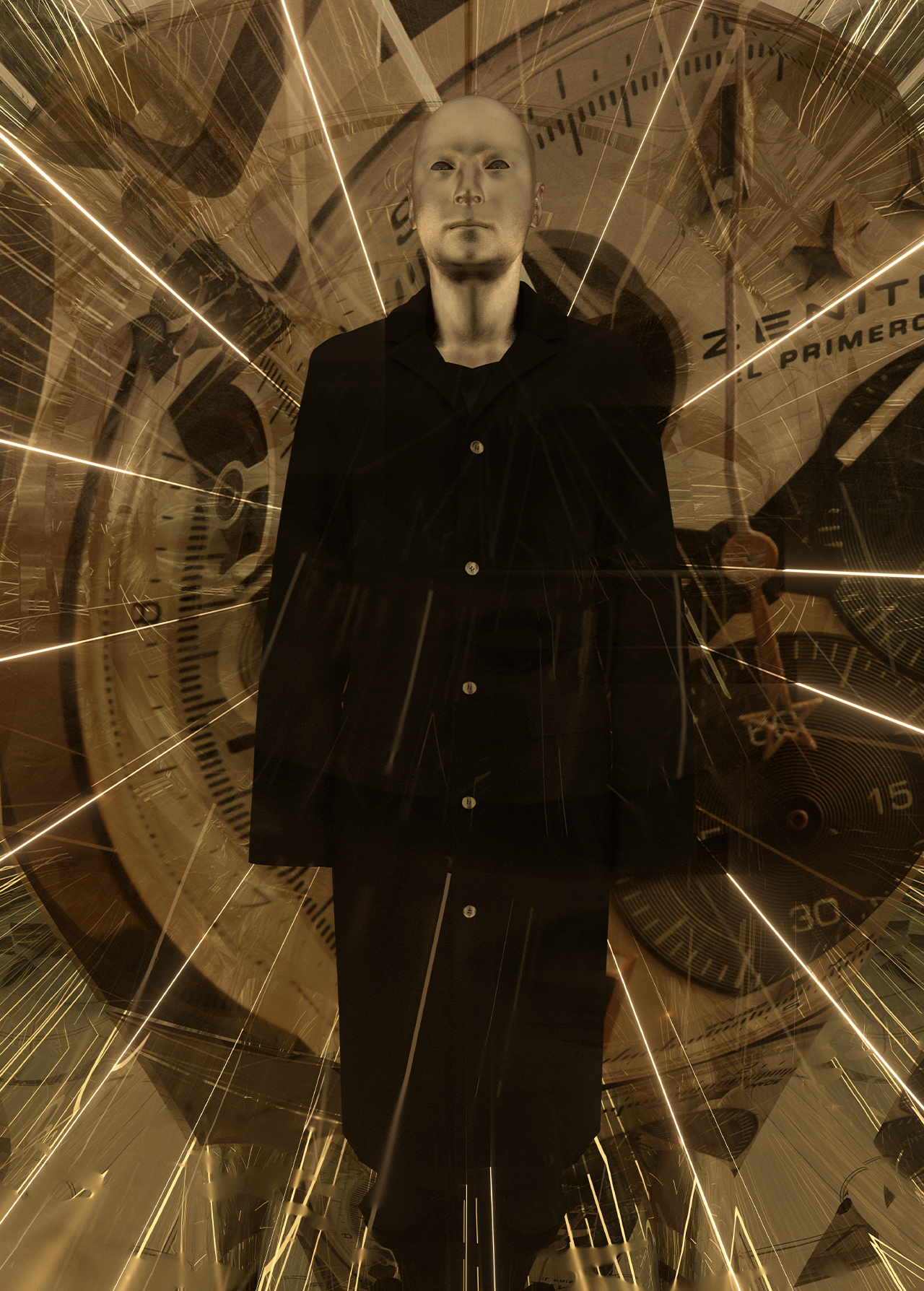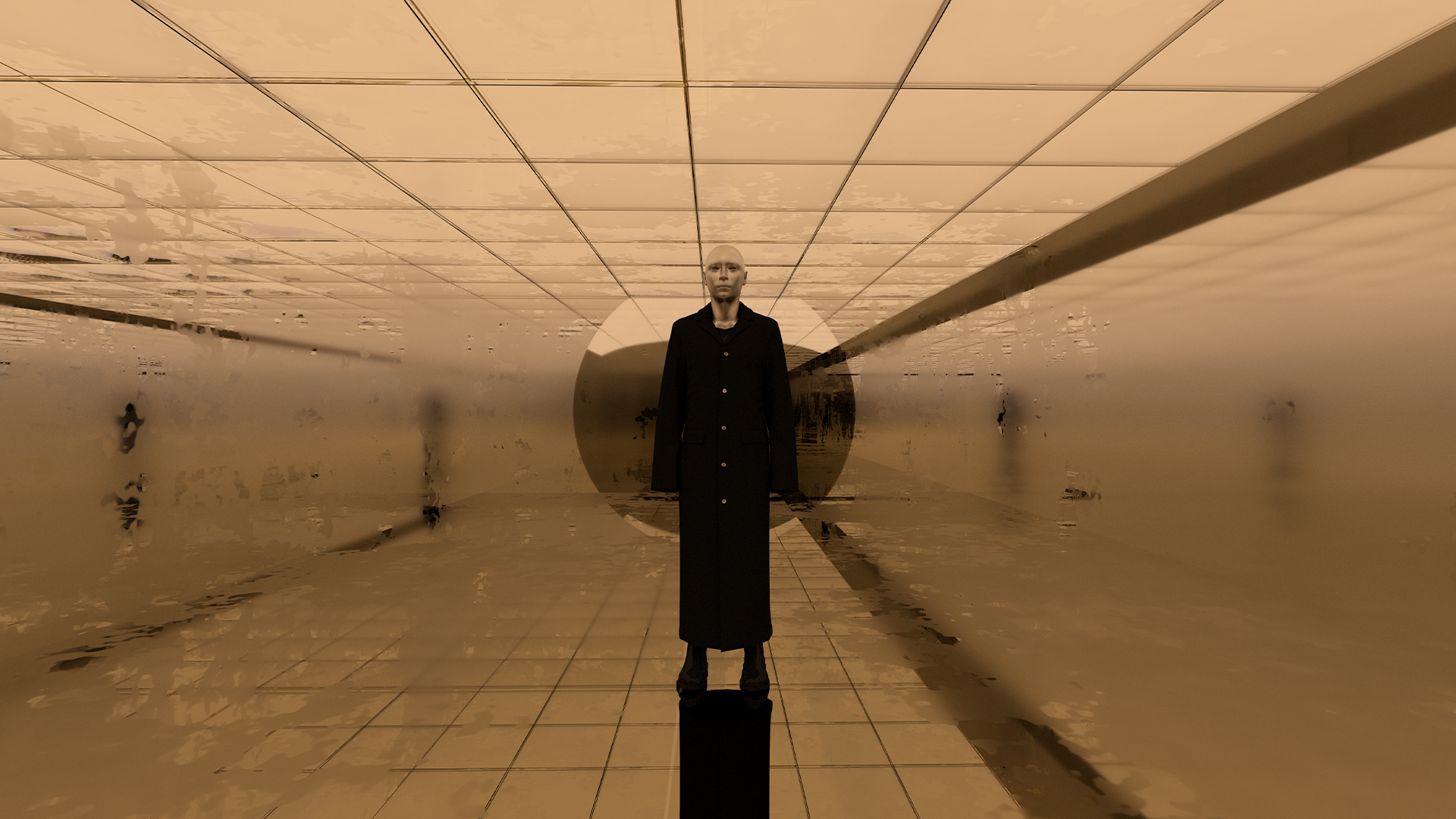Everything
Justin Ridler dissolves technological, artistic and theoretical restraints to conjure his unique style of photography. With a slipstream of real and unreal discords that tamper with the construction of time and space, the Melbourne-based creative breathes existential physics and fragmented dynamics into his multi-disciplinary works. Having previously collaborated with Virgil Abloh, Baz Luhrmann and Toni Maticevski, his nuanced images play with, and challenge, the very expectation of creativity.
For ICON, Ridler examines the modern merging of time with existence. A continuum often annulled by those who seek to rid us of clocked limitations, his distinct blend of virtually-evolved visual arts has the capacity to further explore the concept. He refers to Italian physicist Carlo Rovelli whose universal quantum dissections dispel our need to so literally pinpoint place and time. Rovelli writes “the ability to understand something before it’s observed is at the heart of scientific thinking.” But to cooperate with the unknown is not only at the core of those scientifically speculating, but also within the artists taking technological leaps into a creative void.
A first generation Australian, Ridler is the son of migrant parents who left Calcutta for Australian before he was born. His background curbs his unwavering dedication to his craft, mustering a feverous determination to manifest future-facing ideas. From a young age, inspired by the groundbreaking special-effects of the blockbuster films of his youth, Ridler dreamed of capturing the emotion and connection that comes with producing powerful, new visions. Now, alongside his wife and creative partner, Sarah Woodall, Ridler is marking new territory for conceptual photography. Unlimited by dimension and implementation it’s arguable his is part of the virtual art movement of our time. But what does this all mean to him? Is art inextricably linked to time, or is it simply a viable, expressive portal? He tells ICON, in his own words.

ICON: Is it possible to define your style of art, and this collaboration?
Justin Ridler: The work I do investigates peripheral workflows, and those that come into contact with photography. One of those things is avatar design and virtual productions. But I also have this central thing, as in I still take photographs to make films. This story (for ICON), is an expression of me, as well as our (with fashion director Kim Payne) collaborative ideas. With my work, it’s about finding pathways that interconnect, a kind of ecosystem of different methods of working.
ICON: Did your style evolve out of exploring different technologies or from a more cerebral place?
Ridler: That’s a very good question (laughs). What came first was probably the feeling of suspension of disbelief – something I experienced when I was young watching films like Jurassic Park and other big block-blockbuster, special-effects films. It was the first inkling I had that this was a world I wanted to connect with. But, obviously, if you’re 11 years old and a child of migrant parents, you don’t have millions of dollars to spend on a computer system. So the first thing I wanted to, I wasn’t really able to, from a financial perspective. But I made a decision back then that I would make images for as long as I possibly could. I knew deep down that I needed to make films, and once I felt like I had established a foothold, and understood the processes (of traditional photography), I would change gears and start making movies.
ICON: Is that still something you’d like to do?
Ridler: Definitely. I think it’s certainly still something that we (with Woodall) hold as part of the long term goal. But I don’t think it’s an immediate process and there is certainly a lot of value in where we are and what we’re making right now.

ICON: Has your family been supportive of your creative path?
Ridler: (Laughs) That’s a funny question. Later, yes, but initially not as much. However, if I had the same information my father had when he was giving me career advice, I would have said the same. I think, to a large degree, working as a creative person is a deeply perilous profession. It’s extremely difficult and very, very competitive. You have to keep a constant, relentless forward momentum. But I realised in myself very early on is that I was born to do this. I’m not good at anything else (laughs), so it’s kind of ride or die. I know that’s a bad catchphrase to use, but I really don’t think that I could be anything but a creative person. And I think my father realised it too once he saw evidence of success. At the beginning, I think he was more like, what the fuck are you doing kid?
ICON: There has been speculation that during the A.I. revolution one of the few careers safe from total replacement will be that of original creatives, do you agree?
Ridler: I tend to agree. I’m writing a piece at the moment about the function of A.I. art and whether or not it will be useful past than the initial, sexy, seductive time – and I think the short term answer is that everything’s going to be a bit cooked for a minute. However, I try and sit with the emotion of (art), and put myself in the position of an observer, someone observing art, and what that means to me. For me, art is this incredible prism. We, as creators, make and demonstrate our intentions and ideals through an object, then the observer brings something of themselves and their moment in time to it. It’s just incredible, like a fucking time machine, a moment where you connect with somebody else.
ICON: Does A.I. have to power to disrupt this?
Ridler: I think if the creator of an art object has no life experience, if they haven’t had their heart broken or if they haven’t, you know, lived through a really textured, nuanced moment in time then there’s no statement behind the work. If it’s more just a beautiful role of the dice, then I’m not interested. With what I know of the trajectory of A.I. I don’t believe it threatens the (fundamental creative) mechanism – I think it threatens a whole lot of other mechanisms that exist in the realm of creativity – but that one specific thing, which is the function of art, is fairly sacred. But I might be proven wrong.

ICON: Do you think art has a significant way of stamping a moment in time? Can it create a fundamental connection?
Ridler: It’s such a fascinating question to ask. It makes me think of something Basquiat said, which is “music decorates time and art decorates space” but maybe now virtual art decorates space-time. Certainly art movements punctuate a moment in time. I think we lens time through the expressiveness of our civilisations. Look at, say, the sixties or seventies for example, we view the art that came out of that period and lens it through these visual and audible aids. But this isn’t exclusively what happened in these times, it’s just an abstraction of what happened. So while it does absolutely punctuate the moment, it also abstracts the moment.
ICON: From a future point of view, will our present time be recalled as a virtual, artificial moment in culture and art?
Ridler: I think, no doubt. You know it’s been such a wild moment for art. I feel like up until maybe two or three years ago, everything was moving at a really slow pace. And now in these most recent days, everything is moving at break-neck speed. It’s almost like living through another Renaissance.
ICON: Do you think people are ready for it? Is that why it’s occurring?
Ridler: Well, possibly. We’re seeing not just a renaissance in art, however, but a renaissance in our way of thinking. Our paradigm is shifting so rapidly around everything. And this is not the first time it has happened. It’s not the first time we’ve reevaluated our views on human sexuality and gender, but it’s now an extremely large part of social discord. There’s also a huge momentum in technology, and a looming thread of violence. So, there are a lot of facets that echo the first Renaissance – there’s certainly parallels to be drawn.

ICON: Do you find influence in other creators or thinkers?
Ridler: I think so, a lot of what I do is a response to conversation and ideas. There’s an incredible book called The Order of Time by a physicist named Carlo Rovelli. In it he discusses the nature of time and the differences between how we functionally operate and the actual physics and theory and mechanisms of it. He works to uncover what it means. I think to me, that is really the crux of it – what time means for us. Essentially, it’s the notion that time is this incredible abstraction that occurs within the human organism. An external function of the process of heat exchange and entropy and our position in space and that it is relative to everything else occurring in the universe. It’s like our experience in time is personally subjective, coupled with memory.
ICON: Is the idea of time as a construct a comforting discourse?
Ridler: Yeah. Definitely. I guess I was quite comforted by the notion that everything is subjective and interactive, and truth is just this really personal thing we carry within ourselves. To me, it was a useful learning that I think is evident throughout the work I make. There’s a lot of abstraction and a lot of re-lensing, though it’s not an intended gesture, I’m not trying to directly translate the ideas in the book, but there’s certainly a visceral reaction.
ICON: Given the myriad systems and programs now available, do you find yourself constantly leaning into new technology? Is it something that inspires you creatively?
Ridler: Yeah (laughs), there’s a lot now. I think the real reason for the creative fascination in technology is that the tech itself stamps a moment in time. Like you were saying about art, right now we have access to an array of technologies and the way we engage with them, and the way we find the human in them, is how we will create exquisite works. Throughout the history of art, whatever was at the forefront of technology was used as an expressive device. We have a predisposition to find the textured, nuanced, broken humanness in these non-human machines. Because although they’re not human, they are novel.
In the work I’m doing now it’s difficult to pinpoint where the photography ends and where the virtual starts, and where the voicing of A.I. exists within it. too. That to me is really exciting because – and I don’t by any means claim to be working in this ecosystem of ideas on my own – I can hold processes over each other until they become uniquely my own.

And I’m not just sitting here strategically saying, I’m going to try and be different, it’s not about that at all. It’s more about following inclinations and fascinations until you see a result. It’s like when you’re starting out creating a piece, and then it eventually appears in front of you. You’re like, oh, wow, there it is, you know? For me, it’s this incredible feeling of love and relief. It’s an energy surge where I feel like I caught onto the tail of something that it is now right there in front of me. It’s overwhelming and lovely. It’s not a conscious mechanism of thought, something more subconscious.
ICON: How did you feel becoming a subject matter in your own work, this time?
Ridler: It’s one of the first times I’ve made pictures of myself. And it’s really the first time I’ve had an opportunity to create a portrait style. I’m not so sure that I was that comfortable with the idea of it (laughs), but it was nice and came together organically, with a similar process to my other works.
View more of Justin Ridler’s work at justinridler.net or @justinridler
THIS FEATURE IS PUBLISHED IN THE TENTH EDITION OF ICON PRINT MAGAZINE. ORDER YOUR COPY HERE.
Photography & Art: Justin Ridler
Fashion Direction: Kim Payne
Grooming: Xeneb Allen
EXPLORE THE FULL PHOTO SHOOT WITH JUSTIN RIDLER HERE.
TOP BANNER IMAGE: JACKET WITH REMOVABLE SCARF, SHOP NOW, WOOL TWILL PANTS, SHOP NOW, DIOR MEN